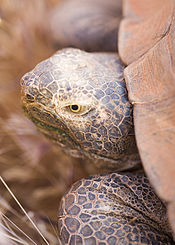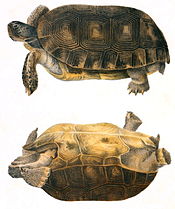- Brazilian giant tortoise
-
Brazilian giant tortoise 
Chelonoidis denticulata Conservation status Scientific classification Kingdom: Animalia Phylum: Chordata Class: Reptilia Order: Testudines Suborder: Cryptodira Family: Testudinidae Genus: Chelonoidis Species: C. denticulata Binomial name Chelonoidis denticulata
(Linnaeus, 1766)Synonyms Geochelone denticulata
The Brazilian giant tortoise, forest tortoise, South American tortoise, South American yellow-footed tortoise, or yellow-footed tortoise (Chelonoidis denticulata, formerly Geochelone denticulata) is a species of tortoise in the family Testudinidae. It is found in Bolivia, Brazil, Colombia, Ecuador, French Guiana, Guyana, Peru, Suriname, Trinidad and Tobago, and Venezuela.
Contents
Physical characteristics and appearance
There are several yellow head scales and a horizontal bar behind its eye. The carapace (shell top) is black with a small, distinct yellow area around the areola on each scute (shell scale). Adult males reach a length of up to 13.5 inches (30.4 cm) in length, while the maximum size of females is 11.25 inches (28.9 cm) in length. Mature specimens have distinctive incurving of sides, giving them a well-defined "waist". The plastron (shell bottom) is a relatively bland yellow-brown; there may be some reddish tint and vague dark marks along areas of more recent growth. The plastron is extremely concave in adult males. Consequently, the male is much lighter than the female. The female has a very flat plastron and short, stubby tail. There is quite a bit of variation in coloring, with the legs and head often having patches of orange, yellow or red. The skin is black with bright yellow marks on the head and lower jaw. Many of the scales on the limbs and tail are bright scarlet. Specimens from west of the Andes have a grayish or brownish carapace. Light limb scales are yellowish or slightly orange, but not scarlet. The plastron ranges from predominantly yellow to black. Note: There is considerable variation in color over the range of the red-footed tortoise, so no one description will accurately describe every specimen.
This species is sexually dimorphic and it is easy to distinguish male and female. The male has an extreme plastral concavity and is subsequently much lighter. There is a pinching off at the midsection of the carapace. The female is much heavier, with a flat plastron and more symmetrical, curved carapace. The female also has a shorter tail compared to the male. The male is quite vocal at mating time with a low moan produced.
The yellow-footed tortoise is much larger with constant yellow markings compared to the red-footed tortoise (Chelonoidis carbonaria).
Natural habitat
There is some disagreement as to which habitat is the preferred type for yellow-footed tortoises. Some feel that yellow-foots prefer grasslands and dry forest areas, and that rain-forest habitat is most likely marginal. Others suggest that humid forest is the preferred habitat. Regardless, they are found in drier forest areas, grasslands, and the savanna, or rainforest belts adjoining more open habitats. The red-footed tortoise shares some of its range with the yellow-footed tortoise. In ranges that are shared in Surinam, the red-footed tortoise has moved out of the forests into grasslands (that are a result of slash and burn agriculture) while the yellow-footed tortoise has remained in the forest.
Behavior
These turtles make a sound like a baby cooing with a raspy voice. Tortoises also identify each other using body language. The male tortoise makes head movements toward other males, but the females do not make these head movements. Male tortoises also swing their heads back and forth in a continuous rhythm as a mating ritual. Mating occurs all year round for the Yellow Footed Tortoise. There is no parental care of the young and the baby tortoises will fend for themselves, starting by eating calcium rich vegetables.
Diet
 A Brazilian giant tortoise at Yasuni National Park, Ecuador
A Brazilian giant tortoise at Yasuni National Park, Ecuador
This South American tortoise eats many kinds of foliage. They are too slow to capture any fast animals. In the wild, their diet consist of grasses, fallen fruit, carrion, plants, bones, mushrooms, excrement, and slow moving animals such as snails, worms, and others they are able to capture. In captivity, they are fed oranges, apples, melons, endive, collard greens, dandelions, plantain, ribwort, clover, shredded carrots, insects, worms, cuttlebone, tortoise vitamins, edible flowers, and alfalfa pellets. Each yellow-footed tortoise in the wild reaches the age of maturity at about 8–10 years. The fecundity of a female generally depends on the size, the bigger they are, the more eggs they can produce. On average, a female will create approximately 6–16 eggs per year, although some female individuals may not reproduce each year. The eggs have brittle shells and are elongated to spherical, approximately 3–6 cm in diameter. The egg size will increase with the body size of the turtle. The young are self-sufficient from birth. The yellow-footed tortoise can live for approximately 50–60 years.
Reproduction and growth
Breeding is synchronized with the onset of the rainy season, (from July to September) where a general increase in activity is noted. Males identify each other eliciting a characteristic head movement, a series of jerks away from and back to mid-position. Another male will make the same head movements. If he gets no head movement in response, it is the first indication that the other tortoise is a female. Scientific experimentation and observation has also indicated that the head coloration has to be correct. He will then sniff the cloacal region of the other tortoise. Copulation usually follows, though sometimes there is a period of biting at the legs. During courtship and copulation the male makes clucking sounds that sound very much like a chicken. There is a set pattern in pitches of the clucking sounds. Rival males will battle, attempting to overturn each other, however neither the males nor females will defend a territory. They are considered nomadic in their movements. It is interesting to note than in almost every tortoise species where male combat occurs, the males are always larger than the females. This is in comparison to aquatic species, where the males are usually smaller than the females and do not engage in male to male combat. It is thought that species with male combat evolved larger males because larger males have a better chance of winning a bout and mating with a female, thus passing on their larger size to their offspring. Species with smaller males evolved because smaller males are more mobile and can mate with a large number of females, thus passing on their genes.
Conservation status
Chelonoidis denticulata is an endangered species. The major populations are located in South America, and they are protected under the Convention on International Trade in Endangered Species, (CITES), Appendix II.
As with many species of turtles and tortoises, many yellowfoots end up as food items in local markets.
References
- Pritchard, (1979) Encyclopedia of Turtles. THF publications.
- Tortoise & Freshwater Turtle Specialist Group 1996. Geochelone denticulata. 2006 IUCN Red List of Threatened Species. Downloaded on 29 July 2007.
Further reading
- Alderton, David. Turtles and Tortoises of the World. New York: Facts on File Publications,1988.
- Halliday, Dr. Tim, and Dr. Kraig Adler, eds. The Encyclopedia of Reptiles and Amphibians. New York: Facts on File Publications, 1986.
- Hagan, J.W. "What's the Difference: Differentiating Geochelone denticulata and Geochelone carbonaria Tortuga Gazette 1989. [1]
- Ward, B. Sedgwick County Zoo. 2 May 2001. [2]
External links
 Media related to Geochelone denticulata at Wikimedia Commons
Media related to Geochelone denticulata at Wikimedia Commons Data related to Geochelone denticulata at Wikispecies
Data related to Geochelone denticulata at Wikispecies
Tortoise family of turtles (Testudinidae) Genus Species of the Tortoise family
Aldabrachelys Astrochelys Angonoka tortoise · Radiated tortoiseChelonoidis Argentine tortoise · Brazilian giant tortoise · Chaco tortoise · Galápagos tortoise · Red-footed tortoiseChersina Cylindraspis† Geochelone Gopherus Homopus Beaked cape tortoise · Berger's cape tortoise · Boulenger's cape tortoise · Karoo cape tortoise · Speckled padloper tortoiseIndotestudo Elongated tortoise · Forsten's tortoise · Travancore tortoiseKinixys Bell's hinge-back tortoise · Forest hinge-back tortoise · Home's hinge-back tortoise · Lobatse hinge-back tortoise · Natal hinge-back tortoise · Speke's hinge-back tortoiseMalacochersus Manouria Psammobates Pyxis Stigmochelys Testudo Phylogenetic arrangement of turtles based on turtles of the world 2010 update: annotated checklist of taxonomy, synonymy, distribution and conservation status. Key: †=extinct. 1=classification unclearOrder Testudines (turtles) Suborder SuperfamilySubfamily
Cryptodira Chelydra · MacrochelysCaretta · Chelonia · Eretmochelys · Lepidochelys · NatatorDermochelysDermatemydidaeDermatemysStaurotypinaeClaudius · StaurotypusBatagur · Cuora · Cyclemys · Geoclemys · Geoemyda · Hardella · Heosemys · Leucocephalon · Malayemys · Mauremys · Melanochelys · Morenia · Notochelys · Orlitia · Pangshura · Rhinoclemmys · Sacalia · Siebenrockiella · VijayachelysAldabrachelys · Astrochelys · Chelonoidis · Chersina · Cylindraspis · Geochelone · Gopherus · Homopus · Indotestudo · Kinixys · Malacochersus · Manouria · Psammobates · Pyxis · Stigmochelys · TestudoTrionychiaCarettochelyidaeCarettochelysTrionychinaePleurodira ChelidinaeChelodininaeHydromedusinaePelomedusa · PelusiosPhylogenetic arrangement based on turtles of the world 2010 update: annotated checklist. Extinct turtles not included.
See also List of Testudines families
 Portal ·
Portal ·  WikiProjectCategories:
WikiProjectCategories:- IUCN Red List vulnerable species
- Chelonoidis
- Reptiles of South America
Wikimedia Foundation. 2010.

